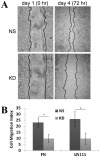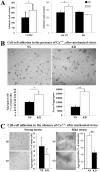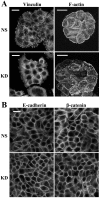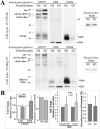Tetraspanin CO-029 inhibits colorectal cancer cell movement by deregulating cell-matrix and cell-cell adhesions
- PMID: 22679508
- PMCID: PMC3367972
- DOI: 10.1371/journal.pone.0038464
Tetraspanin CO-029 inhibits colorectal cancer cell movement by deregulating cell-matrix and cell-cell adhesions
Abstract
Alterations in tetraspanin CO-029 expression are associated with the progression and metastasis of cancers in the digestive system. However, how CO-029 promotes cancer metastasis is still poorly understood. To determine the mechanism, we silenced CO-029 expression in HT29 colon cancer cells and found that the CO-029 knockdown significantly reduced cell migratory ability. The diminished cell migration was accompanied by the upregulation of both integrin-dependent cell-matrix adhesion on laminin and calcium-dependent cell-cell adhesion. The cell surface levels of laminin-binding integrin α3β1 and fibronectin-integrin α5β1 were increased while the level of CD44 was decreased upon CO-029 silencing. These changes contribute to the altered cell-matrix adhesion. The deregulated cell-cell adhesion results, at least partially, from increased activity of cadherins and reduced level of MelCAM. In conclusion, CO-029 functions as a regulator of both cell-matrix and cell-cell adhesion. During colon cancer progression, CO-029 promotes cancer cell movement by deregulating cell adhesions.
Conflict of interest statement
Figures






Similar articles
-
Glycosylation of the laminin receptor (α3β1) regulates its association with tetraspanin CD151: Impact on cell spreading, motility, degradation and invasion of basement membrane by tumor cells.Exp Cell Res. 2014 Apr 1;322(2):249-64. doi: 10.1016/j.yexcr.2014.02.004. Epub 2014 Feb 14. Exp Cell Res. 2014. PMID: 24530578
-
The CD9/CD81 tetraspanin complex and tetraspanin CD151 regulate α3β1 integrin-dependent tumor cell behaviors by overlapping but distinct mechanisms.PLoS One. 2013 Apr 17;8(4):e61834. doi: 10.1371/journal.pone.0061834. Print 2013. PLoS One. 2013. PMID: 23613949 Free PMC article.
-
Structure-function analysis of tetraspanin CD151 reveals distinct requirements for tumor cell behaviors mediated by α3β1 versus α6β4 integrin.J Biol Chem. 2011 Mar 4;286(9):7496-506. doi: 10.1074/jbc.M110.173583. Epub 2010 Dec 30. J Biol Chem. 2011. PMID: 21193415 Free PMC article.
-
The opposing roles of laminin-binding integrins in cancer.Matrix Biol. 2017 Jan;57-58:213-243. doi: 10.1016/j.matbio.2016.08.007. Epub 2016 Aug 22. Matrix Biol. 2017. PMID: 27562932 Review.
-
Functions of alpha3beta1 integrin.Curr Opin Cell Biol. 2000 Oct;12(5):548-53. doi: 10.1016/s0955-0674(00)00130-7. Curr Opin Cell Biol. 2000. PMID: 10978888 Review.
Cited by
-
Tetraspanin proteins promote multiple cancer stages.Nat Rev Cancer. 2014 Jan;14(1):49-60. doi: 10.1038/nrc3640. Nat Rev Cancer. 2014. PMID: 24505619 Review.
-
Pancreatic cancer stem cell markers and exosomes - the incentive push.World J Gastroenterol. 2016 Jul 14;22(26):5971-6007. doi: 10.3748/wjg.v22.i26.5971. World J Gastroenterol. 2016. PMID: 27468191 Free PMC article. Review.
-
Tetraspanins as regulators of the tumour microenvironment: implications for metastasis and therapeutic strategies.Br J Pharmacol. 2014 Dec;171(24):5462-90. doi: 10.1111/bph.12260. Br J Pharmacol. 2014. PMID: 23731188 Free PMC article. Review.
-
Tetraspanin 8 (TSPAN 8) as a potential target for radio-immunotherapy of colorectal cancer.Oncotarget. 2017 Mar 28;8(13):22034-22047. doi: 10.18632/oncotarget.15787. Oncotarget. 2017. PMID: 28423546 Free PMC article.
-
Tetraspanins in digestive‑system cancers: Expression, function and therapeutic potential (Review).Mol Med Rep. 2024 Nov;30(5):200. doi: 10.3892/mmr.2024.13324. Epub 2024 Sep 6. Mol Med Rep. 2024. PMID: 39239742 Free PMC article. Review.
References
-
- Jemal A, Siegel R, Ward E, Hao Y, Xu J, et al. Cancer Statistics, 2008. CA: A Cancer Journal for Clinicians. 2008;58:71–96. - PubMed
-
- Levy S, Shoham T. The tetraspanin web modulates immune-signalling complexes. Nat Rev Immunol. 2005;5:136–148. - PubMed
-
- Hemler ME. Tetraspanin proteins mediate cellular penetration, invasion, and fusion events and define a novel type of membrane microdomain. Annu Rev Cell Dev Biol. 2003;19:397–422. - PubMed
-
- Boucheix C, Duc GH, Jasmin C, Rubinstein E. Expert Rev Mol Med 2001: 1–17; 2001. Tetraspanins and malignancy. pp. 1–17. - PubMed
-
- Nakazawa Y, Sato S, Naito M, Kato Y, Mishima K, et al. Blood; 2008. Tetraspanin family member CD9 inhibits Aggrus/podoplanin-induced platelet aggregation and suppresses pulmonary metastasis. pp. blood-2007–2011–124693. - PubMed
Publication types
MeSH terms
Substances
Grants and funding
LinkOut - more resources
Full Text Sources
Other Literature Sources
Miscellaneous

